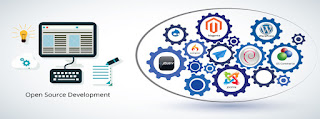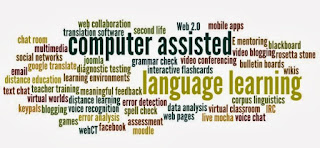Directions: Find words or phrases standing for the following
acronyms with short descriptions.
เทคโนโลยี + สารสนเทศ = เทคโนโลยีสารสนเทศ
https://www.gotoknow.org/posts/380344
reference :
http://nootaa.blogspot.com/2012/08/acronyms-related-to-computer-
technology.html
2. ICT stands for “information and
communications technology” and ICT refers to technologies that provide access to information
through telecommunications. It is similar to information technology (IT),
but focuses primarily on communication technologies. This includes the internet,
wireless networks, cell phones, and other communication mediums.
reference://techterms.com/definition/it
3. CAI stands for computer-assisted
instruction or computer-aided instruction. CAI
is a teaching process that uses a computer in the presentation of instructional
materials, often in a way that requires the student to interact with it. CAI;
instructional activities that use a computer as the primary vehicle for
teaching content or processes rather than one-to-one interaction with a
student. the CAL programs for individual learners. The term most often refers
to drill and practice, tutorial, or simulation exercises used as stand alone
instruction or as supplementary materials.
reference: http://medical-dictionary.thefreedictionary.com/computer-assisted+instruction
4. CALL stands for computer assisted
language learning. Computer
Assisted Language Learning (CALL) is often perceived, somewhat narrowly, as an
approach to language teaching and learning in which the computer is used as an
aid to the presentation, reinforcement and assessment of material to be
learned, usually including a substantial interactive element.
Levy (1997:1) defines CALL more succinctly and more broadly as
"the search for and study of applications of the computer in language
teaching and learning".
reference: https://www.llas.ac.uk/resources/gpg/61
5. WBI stands for Web based instruction.
WBI is a web-based, web-based
instructional program that offers multidimensional multimedia lessons in all
subjects or it just offers some information for teaching purposes. Also take
advantage of the features Communication in the Internet, such as E-mail and chat
with text and audio, is used to achieve efficiency.
reference: http://www.learner.org/workshops/teachreading35/session6/index.html
6. CBI stands for Computer Based
Instruction. CBI is the use of computers as the basis for
lessons. Such learning may take place at an educational institution, a libraly,
a workplace, or the home. Computer resources help at any educational level to better convey information, and allows
students to proceed at a learning rate they are comfortable with. These methods
usually make extensive use of graphics, and often allow
one-click access to the Internet for yet more
information.
7. CMC stands for Computer
Mediated Communication. CMC is a process in which human
data interaction occurs through one or more networked telecommunication
systems. A CMC interaction occurs through various types of networking
technology and software, including email, Internet Relay Chat (IRC), instant
messaging (IM), Usenet and mailing list servers. CMC technology saves time
and money in IT organizations by facilitating the use of all communication
formats.
CMC is
divided into synchronous and asynchronous modes:
·
In synchronous
communication, all participants are online simultaneously.
·
In asynchronous
communication there are time constraints on communication messages and
responses, as with emails.
CMC features include conversation record ability,
formal communication, and user identity anonymity, depending on software type -
such as IM. However, CMC user statement interpretation may be difficult due to
the absence of verbal communication.
reference:
www.techopedia.com/definition/392/computer-mediated-communication-cmc
8. TELL stands for Teaching English
Language Learners.It is the English
teaching for English learners by bilingual education and expertise, then
check out the best teaching strategies, supporting the development of the
knowledge of students who are learning English as a second language. You will
learn how to create a student's language and background experience and how to
create a classroom environment that promotes student’s learning.
9. MUD stands for Multiple User Dialogue. MUD is a computer program that users can visit and
explore. Each user takes control of a person's computer character. You can walk
around chatting with other characters, explore dangerous monsters, solve
puzzles, and even create your very own room. Description and Item You can still
get lost or confused if you jump right in to make sure to read this document
before you start.
reference: http://www.sdmud.com/about/muds/
10.
MOO stands for MUD Object Oriented. MOO refers to the system of communication that is
Synchronous users can interact with each other by typing the text. Choose a
room or place to talk. The conversation must be in a place called the same
room.
reference : http://senarak.tripod.com/mudmoo.html
เทคโนโลยี + สารสนเทศ = เทคโนโลยีสารสนเทศ
เทคโนโลยี
คือ การประยุกต์เอาความรู้ทางด้านวิทยาศาสตร์ ความจริงเกี่ยวกับธรรมชาติ
และสิ่งแวดล้อม มาทำให้เกิดประโยชน์ต่อมวลมนุษย์
สารสนเทศ คือ
ข้อมูลที่เป็นประโยชน์ต่อการดำเนินชีวิตของมนุษย์
เทคโนโลยีสารสนเทศ (Information Technology : IT) หมายถึงการนำเอาเทคโนโลยีมาใช้สร้างมูลค่าเพิ่มให้กับสารสนเทศ
ทำให้สารสนเทศมีประโยชน์ และใช้งานได้กว้างขวางมากขึ้น
เทคโนโลยีสารสนเทศรวมไปถึงการใช้เทคโนโลยีด้านต่าง ๆ ที่จะรวบรวม จัดเก็บ ใช้งาน
ส่งต่อ หรือสื่อสารระหว่างกัน เทคโนโลยีสารสนเทศเกี่ยวข้องโดยตรงกับเครื่องมือเครื่องใช้ในการจัดการสารสนเทศ
ซึ่งได้แก่ เครื่องคอมพิวเตอร์ และอุปกรณ์รอบข้าง ขั้นตอน วิธีการดำเนินการ
ซึ่งเกี่ยวข้องกับซอฟต์แวร์ เกี่ยวข้องกับตัวข้อมูล เกี่ยวข้องกับบุคลากร
เกี่ยวข้องกับกรรมวิธีการดำเนินงานเพื่อให้ข้อมูลเกิดประโยชน์สูงสุด นอกจากนี้แล้วยังรวมไปถึง
โทรทัศน์ วิทยุ โทรศัพท์ โทรสาร หนังสือพิมพ์ นิตยสารต่าง ๆ ฯลฯ
ปัจจุบันคนไทย
ทุกเพศ ทุกวัย รวมถึง "วัยเด็ก" ได้เข้าถึงสิ่งที่เรียกว่าเทคโนโลยีสารสนเทศ (IT) จนกล่าวได้ว่าเป็นส่วนหนึ่งของชีวิตประจำวันไปแล้ว ไม่ว่าจะเป็นคอมพิวเตอร์หรือโทรศัพท์มือถือ หากเราใช้อย่างสร้างสรรค์แล้ว คุณประโยชน์ที่เราจะได้รับนั้นมากมายมหาศาล แต่หากขาดความรู้
ขาดความยับยั้งชั่งใจหรือขาดวิจารณญาณแล้ว สิ่งหนึ่งที่มองข้ามไปไม่ได้คือ
"โทษ" ที่เกิดจากการใช้อย่างไม่ถูกวิธีหรือใช้อย่างไม่รู้คุณค่า
ไม่สามารถแยกแยะได้ว่าสิ่งไหนดีหรือไม่ดี
เด็กเป็นวัยที่ต้องให้ความสำคัญในเรื่องนี้เป็นพิเศษ
ผู้ปกครองควรเฝ้าระวังการใช้เทคโนโลยีต่าง ๆ เพื่อป้องกันการใช้ไปในทางที่ผิด
แต่ยังมีผู้ปกครองอีกจำนวนมากที่ไม่เข้าใจว่า
ภัยร้ายหรืออันตรายที่จะเกิดจากการใช้สื่อเทคโนโลยีมาได้อย่างไร รวมไปถึงไม่มีพื้นฐานในการใช้สื่อต่าง ๆ เหล่านั้น ข่าวการใช้เทคโนโลยีที่ผิดมีให้เห็นกันบ่อยเพราะฉนั้นผู้ปกครองควรตื่นตัวกับการก้าวตามให้ทันกับเทคโนโลยีที่เปลี่ยนแปลงไป
และดูแลเอาใจใส่ลูกหลานของตนในการใช้สื่อต่าง ๆ อย่างเป็นประโยขน์
เพื่อครอบครัว เพื่อสังคม และเพื่ออนาคตที่สดใสของคนในชาติของเรา...
https://www.gotoknow.org/posts/380344
Asynchronous Tools
But when it comes to virtual communication in
support of our classes, asynchronous communication is by far the more popular
model if for no other reason than the barriers to implementation tend to be
much lower—many of these tools are free and require minimal hardware and
software. The drawbacks of asynchronous tools are that they are by nature less
timely and efficient—they are asynchronous, after all. However, planned
excursions with asynchronous tools can turn into synchronous events. In other
words, if students and instructors all happen to be logged in to a discussion
board, conversation can happen in near-real time.
Common examples
of “different
time, different place” tools include:
·
Discussion
boards: whether
integrated into your online learning environment or not (such as Google Groups), well-managed discussion
board can produce incredibly rich conversations about the topics at hand.
·
Blogs: my personal favorite, as not only are
the students discussing with one another (and the instructor), but they’re
learning something about writing for a wider audience who may or may not be
listening in. The open nature of blogs also allows for communication between
students in other classes at other institutions who are studying the same
topics. You might have to make “comment on blogs” count for a grade in order
for some students to do it, but such is the nature of the beast—those students
probably wouldn’t talk in class, either.
·
Social
Networking Sites: Facebook and
Twitter can play important roles in your asynchronous communications strategy.
Facebook pages for a class can be the destination for up-to-date information
about the course, without your students having to friend you (or even one
another). Twitter, and Twitter lists, can be useful sites of asynchronous
discussion, although not in the threaded format that one is used to seeing in a
discussion board setting.
·
E-mail/Reservists: Some people consider mailing lists to be
quaint relics of a previous technological age, but it’s hard to argue with the
fact that they still work: an e-mail based discussion list does afford one the
ability to carry on threaded discussions in a private environment, yet outside
the confines of a managed system (for discussion boards). In fact, Google
Groups ( is a threaded discussion board that can also take place via e-mail,
putting a different twist on the typical concept of the reservist.
reference
:http://www.chronicle.com/blogs/profhacker/tools-for-synchronousasynchronous-classroom-discussion/22902








ความคิดเห็น
แสดงความคิดเห็น